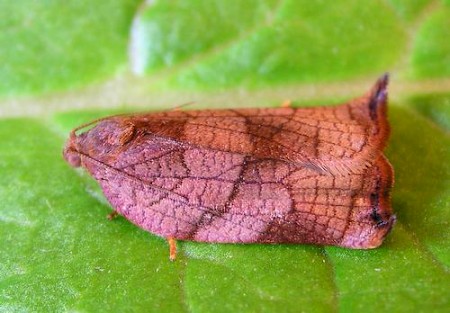49.013 BF977
Large Fruit-tree Tortrix Archips podana
(Scopoli, 1763)
Wingspan 18-26 mm.
Archips podana is quite common in low-lying areas throughout England and Wales, but less so in Scotland.
Sexual dimorphism is quite pronounced. The male has a costal fold on the forewing, and is usually smaller and more brightly coloured than the female. The female has no costal fold, and a much more protruding apex on the forewing.
The main flight period is June - July, but adults can be found from May to September, late emerging specimens possibly being a less numerous second generation. They come readily to light.
The larvae feed on the foliage, flowers and fruit of a wide variety of deciduous trees, including apple (Malus), plum, sloe and cherry (Prunus spp.) and, occasionally, conifers. The usual larval development is to feed July ? September, and, after overwintering, to complete feeding and growth in the following April ? May. But sometimes, full-grown larvae can be found in late August, which pupate and emerge as adults in early September. Final instar larvae usually have brown heads and prothoracic plates, but black also occurs. Archips xylosteana and A. rosana have similar larvae.
Larva: (description Ian F. Smith)
Foodplant: Polyphagous on trees and shrubs, including Malus, Prunus and, sometimes, Coniferae. July ? May, sometimes imago by September.
Length: 16 mm described (final instar, but can reach 23 mm).
Head: Rich chestnut (sometimes black). Posterior and frons thinly edged blackish.
Strong black posterolateral mark with a thinner branch (concealed by prothoracic plate in picture) which curves to form a ?U?. Stemmatal area black.
Prothorax (T1): Elongate black prespiracular pinaculum, and another subventrally. Prothoracic shield translucent yellowish brown (or black). Anterior edge whitish. Divided by thin paler medial line, with a small dark brown spot either side of the line about a third of the way from the posterior. Wide black border on posterior, and laterally.
Thoracic legs: Translucent. Middle leg; base as venter, femur and tibia light brown, tarsus darker brown. On the specimen described, the anterior leg was darker, and the posterior leg paler, than the middle leg.
Body: Finely shagreened. Dull green dorsally, whitish green ventrally. Translucent, showing gonads dull yellowish in A5, and a dorsal line formed by the contractile dorsal vessel which is green thinly edged white.
Spiracles: Fine pitchy black peritreme.
Pinacula: Apart from prothorax (see above), concolorous with body, and only discernible by their lack of shagreen.
Setae: Transparent, fine. Slightly tinted golden.
Anal segment: Anal comb with six transparent colourless prongs.
Anal plate concolorous with abdomen. Feebly sclerotised. May be darkened by frass in transit.
Prolegs: Concolorous with venter. Crochets pale brown.
Pupa: The spatulate cremaster has a medial group of 4 hooked setae and a pair of hooked setae laterally. There are no hooked setae ventrally near the anal slit. A2 and A3 each have a pair of deep cylindrical cavities dorsally.
Similar species: Archips xylosteana and Archips rosana feed on the same plants, and larvae and pupae are very similar. Rearing for confirmation is advisable.

 UKMoths
UKMoths 









